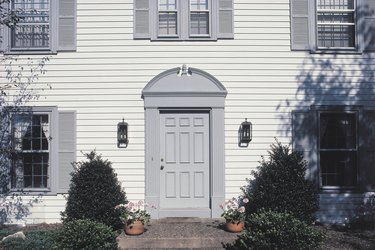
Nothing ruins the look of a new paint job more than air bubbles. The air bubbles may appear before the paint dries or settle in days or even months after you finish painting. The bubbles worsen when the surface pops or depresses, leaving behind craters. The bubbles you see on your front door have several potential causes and solutions that fix the problem.
Causes
Video of the Day
Air bubbles occur when small amounts of air become trapped underneath the surface of the paint. According to Sherwin-Williams, mixing the paint at a high speed may cause air bubbles. The shaking forms air bubbles in the paint, which adhere to the door. Moving a paintbrush or paint roller too quickly over the door may also cause air bubbles, as the rolling pushes air into the paint. Air bubbles also occur when you add a new coat of paint on a wet coat because the wood absorbs the wet paint and leaves space between the layers. Using the wrong paint or clear coat on top of existing paint may also cause bubbles.
Video of the Day
Warning
When left untreated, you risk the air bubbles leaving craters on the surface of the door. The air bubbles look like small or large blemishes on the door. Accidentally pressing or pushing against the door can pop a hole in the bubble. The hole lets moisture seep underneath the paint, which leads to the color peeling away from the surface. The problem worsens with exterior doors because dew, rain and snow seeps under the paint.
Expert Insight
Sherwin-Williams suggests sanding between coats to reduce the risk of air bubbles. After the first coat dries, lightly sand the surface of the door and wipe off any dust before applying your second coat. When mixing your paint, slowly mix the paint with a paint stirrer, which reduces the risk of trapping air in the color. You should also take your time as you paint and watch for any signs of air bubbles forming on the door.
Considerations
Fix the air bubble problem on your door by carefully scraping away the paint over the bubbles with a paint scraper or putty knife. Sand the door with fine-grit sandpaper, removing any paint that may cause bumps in your new coat. If the paint still sticks to the door, apply a small amount of paint stripper and scrape the door again. Paint over the door, feathering the paint on the edges, which lets the coats blend together.